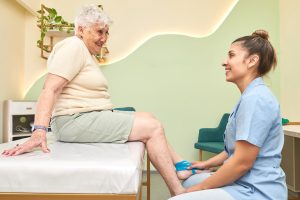What Does a Physical Therapist Assistant Do?
Published - January 3, 2024

What Does a Physical Therapist Assistant Do?
PTAs help people recover from illness, injury, or surgery through exercise and other forms of therapy. Under the supervision of a licensed physical therapist, they provide direct patient care. The goal is to restore functional mobility and improve quality of life.
In this role, you’ll treat patients using proven techniques that improve strength, balance, and flexibility, such as:
Manual Therapy
Manual therapy improves joint mobility, reduces pain, and enhances overall physical function. Techniques include joint and soft tissue mobilization, soft stretching to reduce tightness in muscles, tendons, ligaments, and joints, and myofascial release. Myofascial release is the application of sustained pressure to muscles that release tension in connective tissue.
Massage
PTAs use various massage techniques to relieve pain and reduce swelling. Cross-fiber massage, for example, helps break down scar tissue, improving flexibility and circulation, while deep-tissue massage alleviates tightness.
Ultrasound
Ultrasound therapy has several therapeutic effects, making it a valuable part of a physical therapy regimen. It’s known that high-frequency sound waves can increase blood and nutrient flow to healing tissues, improving flexibility while managing pain.
Hydrotherapy
Hydrotherapy relies on water to facilitate rehabilitation. Applying warm water can reduce muscle spasms and alleviate pain. Cold water can reduce swelling, making range of motion easier.
Therapeutic Exercises
Strength, balance, stretching, and endurance exercises are core components of physical therapy. PTAs assist with passive exercises, movements patients need hands-on help with, and active exercise workouts patients can do themselves with supervision. An essential part of a PTA’s role is to monitor patient progress and adapt treatment plans based on their response. When exercises get too easy, for example, the PTA may add repetitions or increase the difficulty level, making movements more challenging until the patient reaches full functional ability.
PTAs are also educators, working one-on-one with patients and family caregivers to adapt to mobility impairments while maximizing their potential through home exercise plans, adaptive equipment, and safety interventions. As a PTA, you’ll give people the knowledge, tools, and care they need to live life to its fullest.
How Do You Become a Physical Therapist Assistant?
Unlike healthcare careers that require a bachelor’s degree, you can become a physical therapist assistant with an associate degree from a technical college. Programs cover the scientific theory and hands-on skills required to succeed in busy inpatient or outpatient settings. You’ll graduate work-ready and prepared for certification or licensure.
What Do You Learn During a Physical Therapist Assistant Program?
Physical therapist assistant programs include core classes, clinical experiences, and general education courses to help you spread your wings as a person and a professional.
Examples include:
Medical Terminology
You don’t need extensive healthcare experience to become a physical therapy assistant. Programs start at the top with a medical terminology primer. You’ll learn about prefixes, suffixes, and root words, the building blocks of terminology, plus the standard anatomical, pharmacological, and diagnostic terms used in the therapy field.
Anatomy and Physiology
Physical Therapist Assistant programs offer a broad overview of body structure and function, from the cellular to the system level, empowering PTAs to collaborate better and communicate with fellow healthcare professionals.
Functional Anatomy
Functional anatomy refers to anatomy as related to function. PTA students take a comprehensive look at the muscular, skeletal, cardiovascular, and nervous systems, emphasizing the structures and biochemical processes that enable mobility and affect endurance.
Pathophysiology
Pathophysiology is the study of the consequences of disease. This course equips PTAs with the knowledge to recognize and intervene in managing various health conditions that impact function and mobility.
PTA Fundamentals
Students in this course learn about the history, philosophy, and scope of physical therapy and the PTA’s role within the healthcare system. Topics include the regulatory aspects of physical therapy, patient communication, infection control measures, and workplace safety.
Physical Rehabilitation
Physical rehabilitation is a collaborative and holistic process. This class examines the interdisciplinary nature of rehabilitation, focusing on patient assessment, treatment planning, and pain management strategies.
Therapeutic Exercises
Therapeutic exercise addresses musculoskeletal, neuromuscular, and other physiological impairments that affect health and functional independence. Students learn how to develop treatment plans, set goals, document patient progress, and adapt exercise programs for specific patient populations and phases of rehabilitation.
Physical Interventions
“Physical interventions” consist of techniques physical therapist assistants use to treat patients, including manual therapy, myofascial release, joint and soft tissue mobilization, and hydrotherapy. You’ll learn about the scientific basis and applications for each before moving on to practice in a laboratory setting.
PTA Lab
This course provides PTA students with their first hands-on experience in physical therapy. Instructors demonstrate assessment skills and physical interventions using simulations, mannequins, and models in mock clinical scenarios.
PTA Practice
Students in this class consider what PTA practice involves in preparation for off-campus clinical experiences. Topics include communication, ethics, leadership, and professionalism.
Clinical Experience
Clinical experiences consist of short-term periods working in healthcare facilities. Under the supervision of instructors and seasoned PTAs, you’ll work with a broad range of patients, treating various conditions in real-world settings.
Clinical Integration
A culminating experience, this course takes a look back at what you’ve learned since the start of your program, facilitating your transition from the classroom to the workplace through feedback, critical thinking, and self-reflection.
NPTE Exam and Licensure Preparation
Physical therapist assistants are licensed to practice by the state where they seek employment. The National Physical Therapy Examination (NPTE) for Physical Therapist Assistants is the standardized exam administered by the Federation of State Boards of Physical Therapy (FSBPT) to assess your competency as a PTA.
Technical colleges prepare students for success by integrating test topics into every course. This class takes it further with a review of course material, the test format, and study tips from experienced instructors who’ve taken the exam and passed.
Final Thoughts
Physical therapy is an ideal field for health enthusiasts who view wellness as more than the absence of disease. As a PTA, you’ll unlock patients’ potential while cultivating your own. The US Bureau of Labor Statistics projects a 19% increase in demand for physical therapist assistants through 2032, making it a good career decision for yourself and your community.
Practical Therapist Assistant Program
Upon successful completion of the Physical Therapist Assistant program, graduates are eligible to apply for licensure or registration in any state, take the California Law Examination (CLE), and sit for the National Physical Therapy Examination (NPTE)
Contact us now to learn more.



